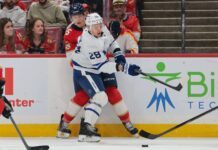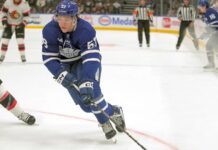The Hockey Coaches Conference came to Toronto for the first time this past weekend.
Hosted at the Mattamy Centre (formerly Maple Leafs Garden), the venue’s multi-purpose facility was a great fit, between the gym set up to host the conference, the arena for on-ice demonstrations, and the alumni lounge for meals and the keynote presentation by Bob McKenzie.
The event organizers and hosts from www.thecoachessite.com were also great. The host of the weekend was Ryan Pinder, who is the co-host of Sportsnet 960 (I wasn’t too familiar with Ryan before the weekend, but he’s a funny, smart guy to talk hockey with).
I met a lot of people throughout the weekend, learned even more, and had fun the entire time. If you would like to watch the videos of the conference there is a paid subscription you can register for. Here are some highlights from the presentations:
Day One
Debunking the 10,000 Hour Rule – Dr. Justin David
- The 10,000 hour rule stems from Malcolm Gladwell’s book ‘Outliers’, which posits that 10,000 hours of “deliberate practice” are needed to become world-class in any field.
I - Justin David argued there are other factors that matter more than practicing long hours: 1) Genetics, 2) Mistakes (players that make mistakes learn faster and grow out of them), 3) Sleep (8.6 hours per night)
Inside the Mind of Elite Hockey Players – Jay Woodcroft
- An NHL coach of the past eleven years with Detroit, San Jose and now Edmonton, Jay shared stories of conversations he’s had with elite NHLers and coaches.
I - There were a lot of quotes related to players wanting positive feedback. I particularly noted a quote from Mark Howe, saying (I’m paraphrasing) that a pat on the back meant more and was more appreciated after a tough game than a tongue-lashing.
I - Scotty Bowman said that the top coaches across all sports are consistent with: Punctuality, discipline, and practice habits.
How to Run an Effective Practice – Stan Butler
- There was a lot to write down in this section; just to keep it high level, the principles of practices were written down as follows:
I- You get better or worse every practice
- Make most improvements in practices, not games
- Competitive attitude should be enhanced in practice
- Repetition is the best way to learn a skill
- You play the way you practice
Building a Winning Culture – Willie Desjardins
- Willie shared a lot of videos in his presentation, and one in particular he kept circling back to was of John Herdman (Canadian women’s soccer coach), who he brought in to speak to the team. I won’t give away too much, but one thing in particular they focused on was something Herdman said: “Touch the heart before you take the hand.” Meaning, build a relationship before you coach someone.
I - I thought it was interesting that the Canucks utilize “player cards” in Vancouver. They look something like this:
I- Teammates can expect from me every night _____
- When I play my best _______
- When I’m having a bad game this is how I still help _____
Analytics in Today’s Game – James Mirtle, Tyler Dellow, Scott Cullen
- The panel touched on a variety of topics that many in the online community would be familiar with such as blocked shots, hits, and the Florida Panthers offseason. One thing that stood out to me, and this isn’t particularly related to the panel, is the feeling in the room on analytics was still tense. Completely subjective, but I didn’t get the feeling that the majority of people knew the theories and conclusions we’ve made on certain analytic topics in the online community (for something as simple as blocking shots not always being good).
I - Dellow outlined an interesting ‘pyramid of success’ with the foundation being zone entries, breakouts and matchups, the next level being shot differential, shooting percentage and save percentage, followed by goal differential, winning, and then the Cup. I’ve never heard anyone lay it out like that.
Developing Defensemen – Troy Smith [on-ice]
- There were three different levels of puck skill drills. First, Smith showed breakouts for defensemen. One attempt was practicing quickly wheeling around the net and leading the charge up the ice. The second attempt was using a fake before coming out with the puck against a forechecker. The third was absorbing contact, pushing off the boards to create space, and then taking the puck out.
I - He also showed passing/skill drills and point shots/walking the line/opening up for point shots before the puck gets to you.
Creating Offense from the Cycle – Jay Woodcroft [on-ice]
- There was lots of emphasis on holding the puck along the wall, being able to read the pressure off your hip, and then spinning off the other way. I would also note jockeying for body position before getting to the puck.
I - There were a few variations of two-man cycle drills with give and go’s with a shot at the end.
Professional Players Panel – Brendan Gaunce, Natalie Spooner, Mike Duco
- The main talking points — players want a coach that keeps them honest, and while they don’t want to be pampered, they do appreciate and crave positive feedback when it is earned (there’s that theme again).
Playing a Puck Possession Game – Jim Montgomery
- This was one of my favourite presentations of the entire conference. I wasn’t very familiar with Jim Montgomery (University of Denver’s head coach) before last weekend, but he’s someone I’ll be keeping an eye on moving forward. He detailed multiple levels of how they keep and advance the puck up the ice, showing video while outlining their strategies and details.
I - The video and explanations are too detailed for me to outline in this format, but I’ll say their basic philosophy boiled down to, “If we control the puck 60% of the games, we’ll win 80% of them.” U. of Denver had a slow start, but ended up losing in the semi-finals of the Frozen Four to the eventual champions North Dakota.
Day Two
Talent Recruitment and Identification – Chris Diepero
- This was a quick 15-minute presentation to start the day, and it centered around sticking to your identity throughout the process and potential criticism.
I - I liked the note on, “what’s your but,” meaning — know what your negative blind spot is so that you can address it while you are evaluating a player.
Linking Your Systems – Dave Smith
- Video was shown in phases; it was shown how to identify what is happening on the ice and what are the necessary next steps.
I - One note I did find interesting is that they don’t look at game tape. They film their practices and review that film because they felt that their players tensed up when they reviewed game tape.
Breakouts off dump-ins vs. Breakouts from DZ coverage – Scott Arniel
- There was a lot shown here that can’t be boiled down to a few sentences, but some key points were using the middle of the ice to breakout, including wingers one-touching the puck to the middle of the ice and shooting the zone on occasion to keep defenses honest.
I - Breakouts off defensive zone coverage were primarily focused on puck retrieval and different defensive zone coverage to get the puck back.
Managing your Players Workload – Catapult Sports
- This is an application that has just been brought into hockey and is something the Leafs are already using. It’s a player-tracking device that measures stride length, workload, etc., and can tell teams things like, “Your player’s stride length has shortened ___ amount, so he might be more susceptible to an injury.”
I - They did note that most of the successful teams over the past few years have shared one thing: the ability to stay healthy. I do think this kind of sports science is the next big thing in sports.
Power Play – Dan Lambert
- This was another one of my favourite presentations. Dan led the Kelowna Rockets to the Memorial Cup final before going to Buffalo, where he worked primarily with the power play. In one season they went from 30th to 12th in the league, and next year he’s going to be the Head Coach of the Sabres’ AHL team, the Rochester Americans.
I - He outlined Buffalo’s nine power play breakouts with notes, mentioning that they never use the same breakout twice within the same power play and different units have different looks (he showed this with video). They focus on three areas with the power play: faceoffs, breakouts, and the offensive zone.
Faceoff Strategies and Techniques – Steve Spott and Bob Boughner
- I really enjoyed this presentation outlining different faceoff plays and strategies. There was lots of video and the chess match of different plays versus various teams was a lot of fun to watch.
I - The four keys to faceoffs were:
I- Personnel
- Bumps and Jumps
- Simplifying your game plan
- Communication (coach calling plays, players being on same page)
Re-thinking how we teach Shooting – Jeremy Rupke [on-ice]
- Jeremy has interactive videos online and he showed the progression of teaching someone how to shoot, with emphasis on facing forward, using your wrists, and building your shot up.
Elite Hockey IQ Skill Development – [on-ice]
- This is Adam Oates’ school. They showed drills that are primarily for private skill sessions or small groups. I liked one drill where the puck was chipped off the wall and players practiced picking the puck up in stride, using one hand to hit the puck to themselves so they don’t have to slow down or lose body position on the backhand.
Assessing your Leadership Style
- A coaching profile test was offered as part of the conference. It was noted that there was no right or wrong to leadership, but there are natural tendencies, and when you over-use them it can become a weakness.
My Coaching Journey – Dallas Eakins
- Eakins outlined his playing career and learning under Roger Nielsen. One story I had never heard before: When he was originally hired by the Leafs to be an assistant coach with the Marlies, Eakins had another offer from Brian Burke for the same position in Portland; the difference being that Burke offered him a three-year deal at good money while the Leafs didn’t offer him as much money on only a one-year deal. He took the Leafs’ deal because he wanted to learn under Paul Maurice since he had NHL experience.
I - He did talk about his time in Edmonton, admitting that when he got there he tried to put out too many fires right away and tried too quickly to get things to where they were with him and the Marlies. It was noted that it probably wouldn’t have made the ultimate difference, but things would have been smoother. I thought at the time of his firing that Eakins would be better for that learning experience, and I still think that. I believe he’ll do much better in round two.
Eakins was the last presenter of the conference, and he hung around for well over an hour afterward talking to coaches individually and swapping stories, the last person being me. Most coaches were very cordial with their time after they presented, but that was first class by Eakins and speaks so highly of him as an individual. I started to feel badly that he was staying so late, but he didn’t mind one bit.
Overall, it was a great weekend. A lot was learned, some laughs were had, and most of all it was great being in a room filled with people who shared one common denominator: A love of hockey.


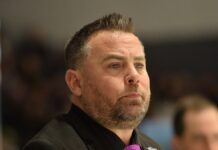


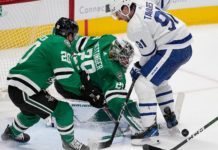

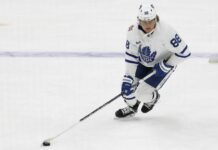




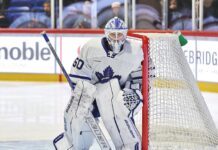

![John Gruden after the Leafs prospects’ 4-1 win over Montreal: “[Vyacheslav Peksa] looked really comfortable in the net… We wouldn’t have won without him” John Gruden, head coach of the Toronto Marlies](https://mapleleafshotstove.com/wp-content/uploads/2025/09/gruden-post-game-sep-14-218x150.jpg)




